Why the iconic Virgin of Charity means so much to Cubans and Pope Francis
especiales
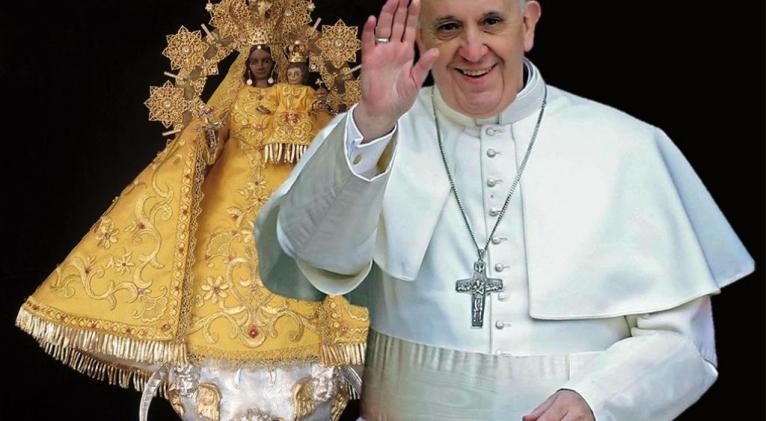
EL COBRE, Cuba — Cubans ascribe to her countless miracles, but perhaps the most extraordinary is how this little lost-and-found statue enshrined on a picturesque hill beside an abandoned copper mine has shown a way to unite believers and nonbelievers, Cubans on the island and Cubans in exile, Christians and followers of Santeria, capitalists and socialists, popes and paupers.
The Virgin of Charity of El Cobre is a perfect symbol of the theme of reconciliation that is woven through Pope Francis’s nine-day trip to Cuba and the United States, and for that he will celebrate a Mass on Tuesday in the nearly century-old Basilica of Our Lady of Charity of El Cobre, which is set against the sky in the dusty hilltop village that takes its name from the Spanish word for copper: cobre.

The golden-clad statue of the Virgin of Charity in a niche above the altar of the basilica in El Cobre, Cuba, where Pope Francis will celebrate a Mass Tuesday. (David Montgomery/The Washington Post)
The influence and example of the Virgin of Charity have long since spread far outside this community and beyond the Catholic Church itself, taking root in popular culture and folk devotions. Her image is everywhere in Cuba: On tattooed arms, the dashboards of taxis, signs for fast food, in makeshift shrines within humble homes. She turns up in movies, novels, songs and cartoons. In a rooftop restaurant in the city of Santiago, not far from El Cobre, it is by no means a musical non sequitur for the trio Los Tres Tristones to sing an homage to Che Guevara followed by an ode to the Virgin of Charity.
The chorus:
And if you go to El Cobre
Where Cachita is
Bring me a little statue
of the Virgin of Charity
Cachita is the affectionate nickname Cubans use to refer to the Virgin of Charity — an informal liberty taken with this manifestation of the mother of Jesus that shows how much a familiar member of the Cuban family she is.

The Basilica of Our Lady of Charity of El Cobre sits on a hill in a former copper mining town. (David Montgomery/The Washington Post)
Over the centuries, the Virgin of Charity has become a quintessential symbol of Cuban identity. Ernest Hemingway, that literary Cubanophile, wrote her into “The Old Man and the Sea,” and he donated his Nobel Prize medal to the shrine at El Cobre. The Smithsonian National Museum of American History has a Barbie doll dressed as the Virgin of Charity by an exiled Cuban artist.
Cubans on the island and Cubans in exile both use the phrase, “The Virgin of Charity unites us.” That phrase “is supercharged with the hope that unity can come in the future through a context of faith … and that the Cuban people can one day be healed and reconciled of these very deep wounds, and that the people in the diaspora and the people on the island can be unified as one,” said the Rev. Avelino Gonzalez, whose family left Cuba in the late 1960s. He is pastor of St. Gabriel Church in Washington, where an annual Mass is celebrated in honor of the Virgin of Charity.
This will be the first papal Mass to take place in the basilica at El Cobre. On previous visits to Cuba, Pope John Paul II and Pope Benedict XVI paid respects and prayed to the Virgin of Charity. The fact that Pope Francis is going a step further has electrified the village of El Cobre, about 20 minutes outside Santiago, and is being interpreted by Cuban Catholics and non-Catholics as another proof that this first Latin American pope truly understands their soul and identity.
On arrival in Havana on Saturday, Pope Francis quickly cited the Virgin of Charity: “She has accompanied the history of the Cuban people, sustaining the hope which preserves people’s dignity in the most difficult situations and championing the promotion of all that gives dignity to the human person. The growing devotion to the Virgin is a visible testimony of her presence in the soul of the Cuban people…. I will have occasion to go to El Cobre, as a son and pilgrim.”
As the pope spoke, on the other side of the island in El Cobre, the pilgrims arrived, as they do every day. Yesenia Rojas Coll walked barefoot up the long stairway to the basilica, wearing a yellow shawl and carrying her six-week-old baby Miguel Alejandro Fuentes Rojas, clad in a yellow tunic and yellow socks. Yellow is the color associated with the Virgin of Charity, and the sanctuary was filled with sunflowers.
A blood clot in Rojas Coll’s leg during her pregnancy threatened the viability of her unborn child and her own ability to walk. She is a doctor who does not believe in God, she said, but she asked the Virgin to protect the fetus and her health. If her baby was born healthy and she, too, recovered, she promised to travel to El Cobre from Guantanamo, some hours away, with the child and a bouquet of sunflowers, and she would approach barefoot with a letter of thanks to be deposited in the room set aside for offerings.
“The Virgin kept her promise, and I kept mine,” Rojas Coll said as little Miguel squirmed.
“We feel the Virgin inside, even if we are not believers” in God, said Rita Coll Bouly, Miguel’s grandmother. “It is the Cuban faith, the idiosyncracy of our people. Wherever there is a Cuban, there is a Virgin of Charity.”
The story of the Cuban Virgin of Charity begins in 1612 when an African slave and two indigenous Cubans rowed a boat to collect salt in the Bay of Nipe. (Now they are immortalized as “the three Juans” who appear in their boat at the Virgin’s feet in posters, paintings and carvings.) They spotted a 16-inch statue of Mary on a tablet floating on the waves. In the statue’s left hand was baby Jesus, in the right a cross. A sign beneath the statue said, “I am the Virgin of Charity.” The statue’s clothes were miraculously dry.
Popular veneration took root, and the statue was installed in a succession of churches at El Cobre. A turning point in her broader appeal outside the church came in the late 19th century, when Cuban fighters in the struggle for independence against Spain petitioned her for help in their cause. The independence partisans were known as mambises, and Cachita became the Virgin Mambisa, or, roughly translated, the Virgin for Cuban Independence.
The Vatican named the Virgin of Charity the patroness of Cuba in 1916, in response to a petition from veterans of the struggle for independence. Pope Francis himself, in his remarks in Havana, referred to her as the Virgin Mambisa.
At the same time, under the influence of Cuba’s distinctive blending of religions, the Virgin of Charity became associated with the Santeria deity Oshun, responsible for sensuality, love, fertility and other qualities.
After the triumph of Fidel Castro’s revolution in 1959, when for decades public religious devotion was scarcely tolerated, “the Virgin went underground,” said Emilio Cueto, a Washington-based Cuban-American historian of Cuban culture who this year published a lavish illustrated chronicle titled “The Virgin of Charity in the Soul of the Cuban People,” which he donated to every public library in Cuba.
Still, popular affection for Cachita persisted, and by 2010-2011, the official attitude had reversed, and the government collaborated with the Catholic Church in a massive tour of the Virgin of Charity around the island in anticipation of the 400th anniversary of the appearance of the statue in 2012.
“The fact that the government not only allowed it but cooperated was a major development,” said Margaret Crahan, director of the Cuba Program at the Institute of Latin American Studies at Columbia University.
Today, the statue — said to be the same one recovered by the three Juans in 1612 — is on a pedestal behind glass above the altar of the basilica. The Cuban flag is embroidered on the statue’s golden garments.
On Saturday, a family including a teenage girl named Saylisa Leon, who was dressed in a long white gown, approached and bowed their heads. They were marking her quinceanera. The basilica is a traditional stop for families celebrating that rite of passage. Saylisa proceeded to the side room where tokens of thanks are deposited. These include high school diplomas, college theses, sports trophies, military stripes and pictures of babies. The girl lit a candle.
“I chose to come here because it’s a change of life, and I wanted to ask for good things for this change in my life,” Saylisa said after her prayers.
In front of the basilica, Yolanda Cabrera and her husband, Juan Figuerero Remon were holding two little statues of the Virgin that they bought as part of saying thanks for helping their two young granddaughters through a health crisis. Cachita has never let Cabrera down, she said, even though she’s not a church-goer.
“I asked her for a man that I would want for myself,” she says, pointing at her husband. “And we’ve been married for 26 years.”

Yolanda Cabrera and Juan Figuerero Remon stand in front of the basilica with their granddaughters, Rachel, 2, and Lianet, eight months. The grandparents thanked the Virgin of Charity for helping the girls recover from health problems. (David Montgomery/The Washington Post)
Church prelates say they are not troubled that the Virgin has been adopted by so many people without other traditional elements of Catholic faith. On the contrary, they say, it proves the profound ecumenical appeal of Mary, and perhaps she will open channels for deeper engagement with the faith.
Some of the diplomas and other tokens of thanks in the side room are in English, left by Cuban Americans who have returned for a visit. The Virgin of Charity’s promise of hope and her link to Cuban identity have crossed seas and frontiers with no apparent decline in potency.
“She traveled alone only once, and since then we’ve taken her with us as a symbol of our country,” said Cueto, whose book on the Virgin documents scores of places where images of the Virgin have turned up wherever Cubans have touched down, on all the settled continents.
In the parish and the village of El Cobre, everyone has been pitching in to get ready for the pope’s visit.
“It’s like preparing for a party for the entire world,” said Milvian Rodriguez Despaigne, who sings in the basilica choir, explains matters of faith to the curious and offers candles to those giving thanks. She was wearing a T-shirt that said, “The Virgin of Charity unites us.” “My mother says that devotion to the Virgin of Charity is in the blood of every Cuban,” she said.

Melvin Rodriguez Despaigne, Milvian’s brother, is music director and choir director for the parish. He composed some of the music for the papal Mass and enlisted other local composers to create other pieces. Music during a portion of the Mass following the consecration of the wine and bread for communion will feature Afro-Cuban rhythms, while other selections will be in a classical style.
A song of welcome that a children’s chorus will sing to welcome the pope when he arrives in Santiago includes the refrain:
Pope Francis, fill this land with love and grace
Pope Francis, fill this land with faith and hope
“The day the news broke that Francis was going to visit, I saw people crying, laughing, people so excited they didn’t know what to do,” Melvin Rodriguez said.
“The Virgin of El Cobre has protected our people for many years,” he continued. “She accompanied the mambises. She accompanied the rebels [with Castro] in the Sierra Maestra. She also accompanied Cubans who traveled around the world…. The Virgin is Cuba.”


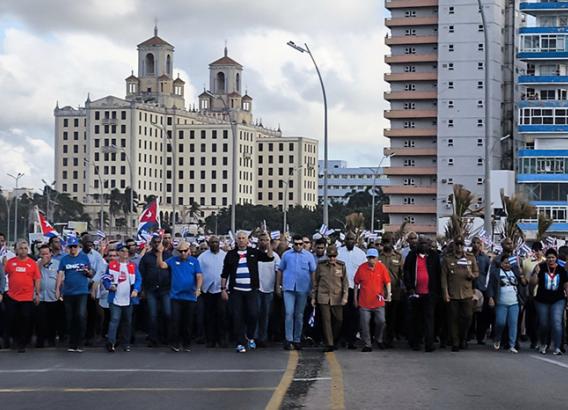
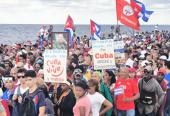

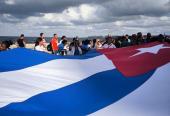
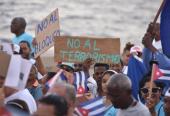
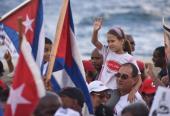


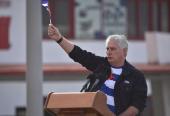
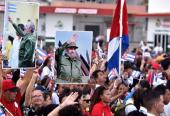

Add new comment